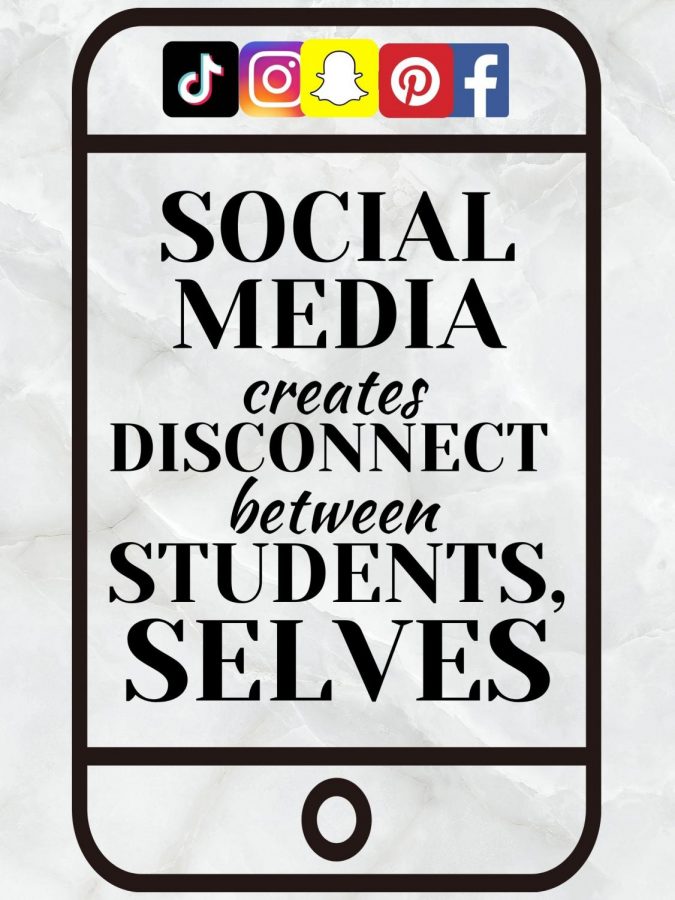Social media creates disconnect between students, selves
Time, relationships, self reflection restricted with online platforms
More stories from Heather Jackson
photo or infographic by Heather Jackson
PSEUDO SOCIAL INTERACTION. Social media is a part of everyday life. Time, relationships and self confidence dwindle as screen times increase.
Social media has become the norm for many students and the simple high school lifestyle. While sending snaps and posting stories can help people stay connected, there are benefits to getting off of the apps and truly living in the surrounding world with present company.
Social media has caused a disconnect in teens, not just from reality but from each other and more importantly, from themselves.
One of the most prominent issues with social media is how much of the day it eats up. People spend hours of isolation staring at a screen that simply flashes nonsensical content before their eyes. A quick snack and flip through stories after school seem harmless until, before they know it, two hours of potential productivity have been thrown away. Students respond to a snap and realize hours have passed that could’ve been used on sleeping in preparation for the day to come. It is easy. It is easy to get sucked into thirty-second videos and amusing memes, but the best thing to do is not always the easiest option available. Scrolling is an easy fallback not just for hours of procrastination, but in the few minutes people spend waiting- waiting in line, waiting for class to start, waiting until it is time to leave before school. This waiting time used to be something different. It used to be a time when people could be alone with their thoughts and actually fashion an original idea that Reels didn’t plant. These few minutes used to be the time to meet and talk to people. Now, it is the time to mindlessly scroll while students go an entire school year without knowing the names of people sitting not ten feet from them. The countless hours and precious minutes are what students lose when they get pulled into the world of social media with no regulations, restrictions or self-control.
Social media was originally branded as a way to connect with people, but it has done just the opposite. While it does allow us to quickly contact others, it is a pseudo form of true interaction. Simple pics and meaningless streaks are nothing compared to a real face-to-face interaction. If the 2020 quarantine had left a lesson, it would be on the importance of human contact with a real person in real-time. Behind a screen, people can be anything they want. They can be seen as whoever they wish to portray even if it couldn’t be farther from the truth. Even in the deep conversations, over not just DMs but text messages as well, it is not the real experience. People can formulate words and phrases to sound perfect in every way. This creates unrealistic expectations in the minds of those sending and receiving messages. The raw experience of real interaction is what students are missing. Social platforms make it easy to feel connected to others while being in absolute solitude at the same time. Because people connect on social media, it may be used as an excuse to not go out of their way to have a real conversation, a real experience, a real friend.
As addressed before, social media can consume priceless hours and minutes of true productivity and social interaction, but there is another aspect of having eyes glued to a screen that many people do not speak about- lack of self-confidence, self-connection and personal time. People only post what they want others to see. Most people only post the happy events: vacations, birthdays, and when they feel good about themselves. What people don’t often see are the insecurities, the problems at home, the struggles in school, the fatal flaw in a relationship. When students only see what makes other’s lives perfect, they can begin to doubt themselves. They can begin to believe the lie that everyone’s life is good apart from theirs. They can begin to compare situations that are not at all comparable with only half of the information. In some cases, as the social media hours go up, self-confidence can fall lower and lower until, once again, the student is lost in a sea of uncertainty and stay in a dark cave away from reality. This escape from reality and the time spent occupying thoughts disconnects teens away from themselves. Time alone is what shows people who they really are, what their motivations are and who they can become without the help of another. People used to have hobbies, people used to read, people used to spend hours on end with friends and family. This is not to say this does not happen anymore, but that is far less common than in the days before the black hole that is made up of various social media platforms.
Social media can help others stay connected, but without regulations and self-control, it is a rabbit hole of endless feed that just takes one further and further from grasping reality. There is value in face-to-face interaction and alone time that doesn’t consist of comparing oneself to others or scrolling mindlessly. By regulating how much time is spent on social media, it can become apparent that twenty-four hours is more than enough for a truly meaningful day. Set aside time for hobbies, spend time with family, have an original idea and make real friendships that take more than a picture once a day to maintain. Stop comparing, end pseudo connections and say no to social media.
Your donation will support the student journalists of Willis High School. Your contribution will allow us to purchase equipment and cover our annual website hosting costs.


